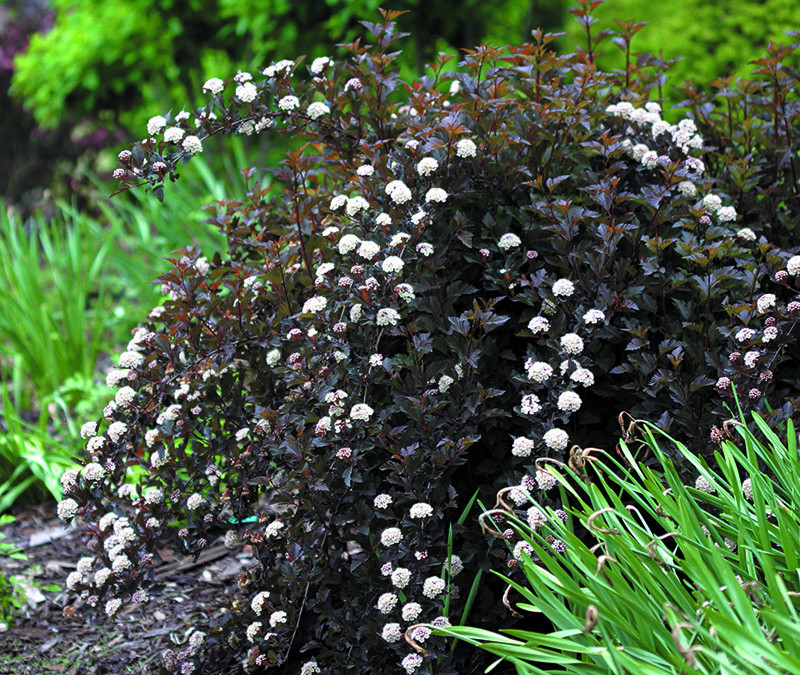Summer Wine Ninebark: The Showstopping Shrub That Will Brighten Your Landscape
Summer Wine Ninebark is a showstopping shrub that will brighten any landscape. It is known for its large, showy flowers that bloom in the summer, as well as its colorful foliage that changes throughout the seasons. Summer Wine Ninebark is a relatively low-maintenance shrub, making it a great choice for busy gardeners.
Introduction
Summer Wine Ninebark (Physocarpus opulifolius 'Summer Wine') is a deciduous shrub that is native to North America. It is a member of the rose family and grows to be 4-6 feet tall and wide. Summer Wine Ninebark has bright green leaves that turn orange, red, and purple in the fall. In the summer, it produces clusters of white flowers that are 2-3 inches in diameter. The flowers are followed by small, red fruits.
Summer Wine Ninebark is a hardy shrub that can tolerate a wide range of conditions. It prefers full sun to partial shade and well-drained soil. Summer Wine Ninebark is drought tolerant once established, but it does appreciate regular watering during the first year after planting.
Main Content
Summer Wine Ninebark is a versatile shrub that can be used in a variety of landscape settings. It can be planted as a standalone specimen, in a hedgerow, or in a mixed border. Summer Wine Ninebark is also a good choice for pollinator gardens, as it attracts butterflies and bees.
Here are some tips for growing Summer Wine Ninebark:
- Plant Summer Wine Ninebark in full sun to partial shade.
- Choose a site with well-drained soil.
- Water regularly during the first year after planting.
- Fertilize once a year in the spring with a balanced fertilizer.
- Prune in the spring to remove dead or damaged branches.
Summer Wine Ninebark is a relatively pest- and disease-free shrub. However, it can be susceptible to powdery mildew. If powdery mildew develops, treat it with a fungicide according to the label directions.
Conclusion
Summer Wine Ninebark is a beautiful and easy-to-grow shrub that can add a touch of color and interest to any landscape. If you are looking for a low-maintenance shrub that will brighten your yard, Summer Wine Ninebark is a great choice.
If you're looking for a beautiful and easy-care shrub that will add a splash of color to your garden, look no further than physocarpus opulifolius 'Summer Wine'. This variety of ninebark is known for its dark, wine-colored foliage that turns a brilliant scarlet in the fall. It also produces clusters of white flowers in early summer.
'Summer Wine' is a fast-growing shrub that can reach heights of 6-8 feet. It is hardy in USDA zones 3-7 and prefers full sun to partial shade. It is also relatively drought-tolerant and pest-resistant.
If you're interested in learning more about 'Summer Wine' or other varieties of ninebark, I recommend visiting Garden Wiki. This website has a wealth of information on ninebark, including planting, care, and propagation tips.
FAQ of physocarpus opulifolius summer wine
1. What is Physocarpus opulifolius Summer Wine?
Physocarpus opulifolius Summer Wine is a deciduous shrub that is native to North America. It is known for its colorful foliage, which emerges yellow in spring, turns lime-green in summer, and then shades to yellow in fall. The plant can grow to be 6-8 feet tall and wide, and it blooms in late spring with clusters of white flowers.
2. Where does Physocarpus opulifolius Summer Wine grow best?
Physocarpus opulifolius Summer Wine is a hardy plant that can tolerate a wide range of climates. It prefers full sun but can also tolerate partial shade. The plant prefers moist, well-drained soil.
3. How much care does Physocarpus opulifolius Summer Wine require?
Physocarpus opulifolius Summer Wine is a relatively low-maintenance plant. It does not require regular pruning, but it may benefit from a light trim in early spring to remove any dead or damaged branches. The plant should be watered regularly during the first year after planting, but it is drought-tolerant once established.
4. What are some common pests and diseases of Physocarpus opulifolius Summer Wine?
Physocarpus opulifolius Summer Wine is susceptible to a few pests and diseases, including:
- Aphids: Aphids are small, soft-bodied insects that can suck the sap from plant leaves. They can cause leaves to wilt and curl.
- Powdery mildew: Powdery mildew is a fungal disease that causes white, powdery spots to appear on leaves. It can weaken the plant and make it more susceptible to other diseases.
- Scale insects: Scale insects are small, armored insects that attach themselves to plant leaves and stems. They can suck the sap from plants, causing leaves to yellow and drop.
5. How can I propagate Physocarpus opulifolius Summer Wine?
Physocarpus opulifolius Summer Wine can be propagated by softwood cuttings in early summer or by division in fall or spring.
Image of physocarpus opulifolius summer wine
- Image 1: A close-up of the foliage of a physocarpus opulifolius summer wine shrub. The leaves are a deep burgundy color with a slight yellow variegation.

- Image 2: A full-size physocarpus opulifolius summer wine shrub in full bloom. The flowers are a soft pink color and are arranged in clusters on the branches.

- Image 3: A physocarpus opulifolius summer wine shrub in fall. The leaves have turned a brilliant red color.

- Image 4: A physocarpus opulifolius summer wine shrub planted in a flower bed. The shrub is surrounded by other flowering plants, such as coneflowers and rudbeckias.

- Image 5: A physocarpus opulifolius summer wine shrub in a hedgerow. The shrub is planted with other shrubs, such as viburnums and hydrangeas.

Post a Comment for "Summer Wine Ninebark: The Showstopping Shrub That Will Brighten Your Landscape"